LAST EDITED ON Nov-29-15 AT 09:28 PM (EST)
This week's Gun of the Week is the Nagant Model 1895 revolver: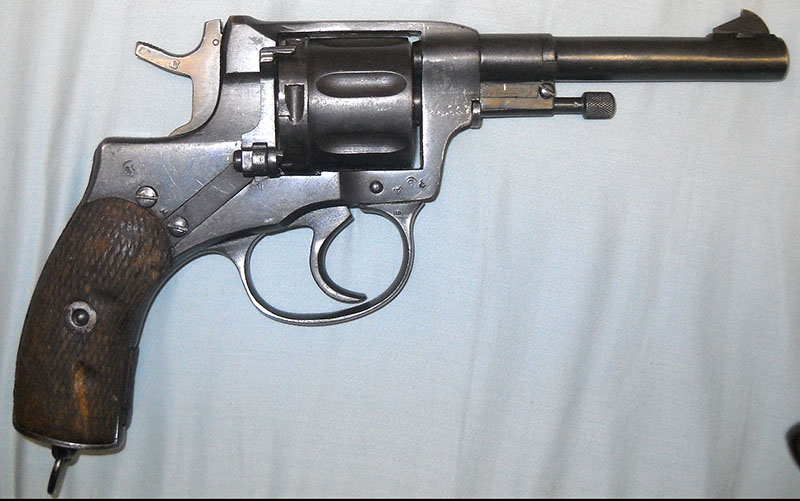
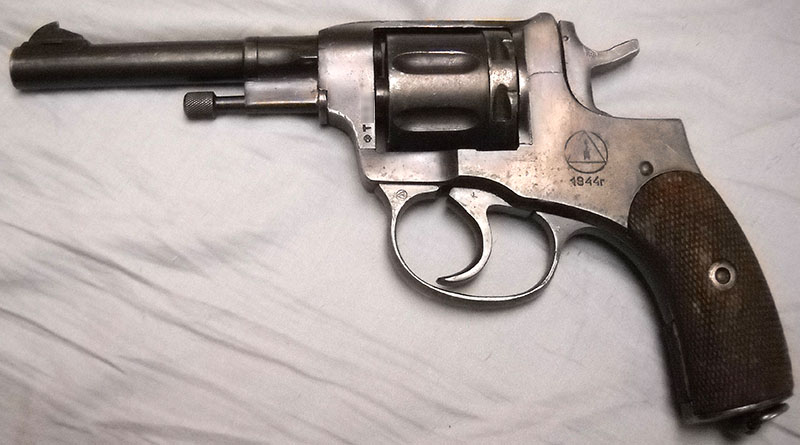
Belgium has recently been in the news as the apparent staging ground for the November 13 terrorist attack on Paris. Much has been made in the press about the country's (comparatively with the rest of mainstream Europe) lax firearms laws and its allegedly consequent status as a sort of European criminal arms bazaar. It's not my intent to address the validity of that assertion; I am personally dubious about it, but acknowledge that I lack the expertise on the subject to make an informed judgment. What I will note is that Belgium has been one of the hubs of the Western world's arms trade for a surprisingly long time, given the relatively small size and low political significance of the country. The history of modern European firearms would have some very large gaps in it without Belgium, particularly the city of Liège and its environs, which is one of the gunsmithing centers of western Europe.
The brothers Nagant, Émile and Léon, came from Liège, and their careers are a good case in point of another recurring feature of the Belgian arms industry: Because the Belgian Army is not exactly large, many Belgian firms made their names and their fortunes developing and producing arms for other countries' armed forces (and the general civilian market, of course, but even back then, military contracts was where the real money was). In the Nagant brothers' case, they did most of the work for which they're remembered today for the Russians. Émile is the Nagant in "Mosin-Nagant", which is what the standard Russian service rifle of both World Wars is called by everyone except the Russians*, and Léon's main contribution was the Model 1895 revolver.
The thing you have to remember here is that Russia in the 1890s could barely be considered an industrialized country, far less an industrial power as such. Before the Soviet era, industry was largely unknown in Russia outside a handful of major cities, and even in those cities, it was fairly light industry. Virtually all the Tsar's military hardware was bought in, and even what could be produced locally was often still engineered by foreigners. This isn't because (as Westerners often sneered in those days) the Russians weren't smart enough to engineer firearms, it was just that they didn't have very many actual trained engineers.
As it happened, the Nagant is a small enough machine that it only took three years for the Russians to put together a factory to build them under license in Russia, so they only had to import revolvers produced in Liège until 1898. After the Bolsheviks took power in 1917, they not altogether surprisingly stopped paying the license fee, but not altogether surprisingly kept making the guns.
The Nagant has an unusual operating mechanism, which addresses a common problem with revolvers (then and still today), namely, the problem of cylinder gap. In most revolvers, there is a small space between the front of the cylinder and the barrel. When firing, gas escapes at that point, which has a couple of undesirable effects. For one thing, it reduces chamber pressure and therefore muzzle velocity, making the weapon less powerful than it could be. For another, the escaping gas acts not too unlike a very sharp blade, causing significant damage to anything that happens to be alongside the gap - for instance, an incautious shooter's fingers. In the late 19th century, two-handed handgun shooting had not come into vogue, so the latter wasn't a huge concern, but other things could occasionally find their way into danger, and reduction of power was a concern, as were the extra flash and noise.
The Nagant solves this by employing a peculiar cartridge design in a slightly odd way. Here is a 7.62x38mmR cartridge (on the right) with a more conventional .38 Special cartridge on the left for comparison's sake.
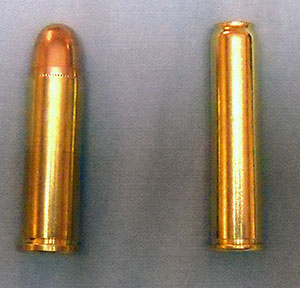
Notice that on the Nagant cartridge you can't see the bullet from the side. That's because it's completely inside the case, below that crimp at the top:
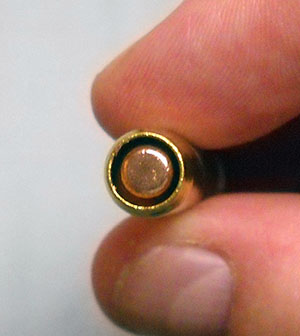
The case is actually very slightly longer than the cylinder; when the revolver is loaded, it protrudes just a tiny bit beyond. I've loaded it with spent cases in this photo so you can hopefully see that; it's most obvious with the round currently at the bottom of the cylinder.
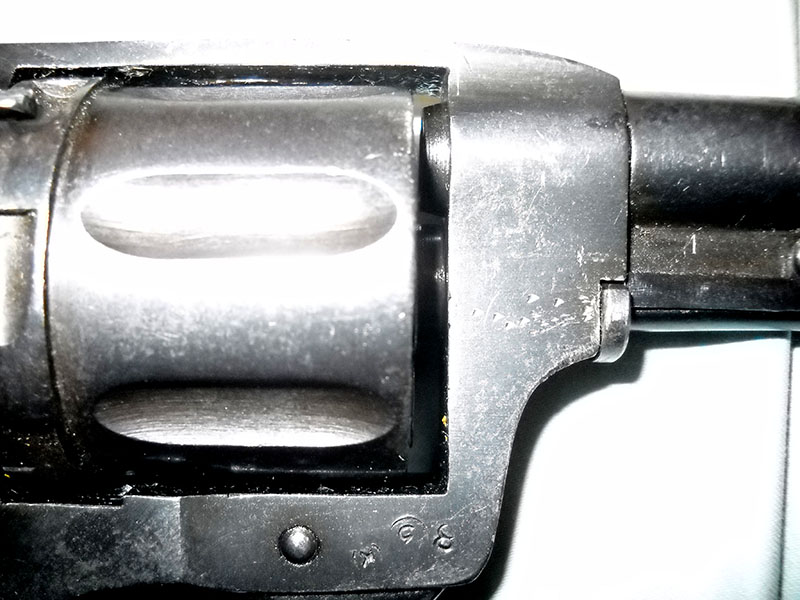
The other half of the Nagant's gas seal system is the way its cylinder lockup works. Note the conical structure at the back of the barrel, facing toward the topmost chamber of the cylinder. That's called a forcing cone, and is where the bullet passes out of the cylinder and engages with the rifling in the barrel. All revolvers have them, but the Nagant's party trick is that, in addition to indexing the cylinder (that is, rotating it to present the next round to the barrel), the mechanism that cocks the hammer also moves the cylinder forward slightly, pushing that tiny protrusion at the front of the case into the forcing cone.
Here's that same shot with the hammer cocked.
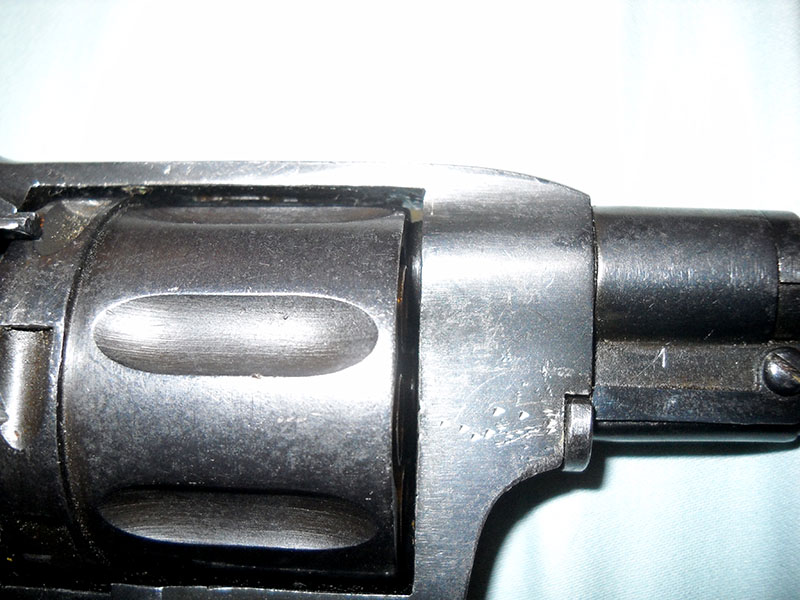
Notice how the gap between the cylinder and the forcing cone has closed? That's the gas seal in action. When you fire the round, the expanding gases push the bullet through the crimp at the front of the case, and the gas pressure conforms that tiny overhang against the inside of the forcing cone, causing a theoretically complete seal between cartridge and barrel. Result: no gas leakage at the cylinder gap. Therefore, in theory, the gun is quieter, safer to use, and more powerful than it would otherwise be. In practice, the power gain is negligible (the figures I've seen claim that the gas seal is good for another 75 feet per second or so at the muzzle), but it does cut down on noise** and indisputably makes the area immediately around the sides of the gun a safer place to be.
There's a downside to this, though. Well, a couple of downsides, actually. First, the ammunition is very specialized. Nothing else uses the 7.62x38mmR cartridge, which is why when you do find it for sale (the Serbian ammunition company PRVI Partizan recently put it back into production for the specialty market), it's a) pretty expensive and b) usually just marked "7,62mm NAGANT".
More importantly, however, because it's a revolver, all the mechanical energy necessary to engage that gas seal system has to come from the shooter's hand, and that, along with the general unsophistication of the mechanism, means the heaviness of the Nagant's hammer and trigger pulls is legendary.
There were originally two versions of the pistol, a single-action one for the rank and file and a double/single-action for officers. Oh, actually, since this is the first time this has come up in Gun of the Week, I should probably explain that in case anyone out there doesn't already know. Single-action refers to a firearm in which the operating mechanism - usually a hammer, but sometimes a spring-loaded striker - has to be cocked by some external force before the trigger will cause it to fire. In a single-action semiautomatic, this is taken care of by the functioning of the gun, which we'll talk about in a later episode. In a revolver, that means the user has to pull back the hammer manually, which cocks the trigger mechanism and generally also indexes and locks the cylinder. A double-action system is one in which pulling the trigger draws the hammer back (and does all that other business, in a revolver), then lets it fall to fire the round. (It's usually not possible to cock the hammer via the trigger without firing, and generally inadvisable to try.) "Double/single-action" just refers to a double-action system where you can cock the hammer manually and fire single-action if you want to. This is as opposed to double-action only, where the hammer can't be cocked, and in some cases can't even be accessed by the shooter (as in, for instance, some compact Smith & Wesson revolvers, where it's fully enclosed in the frame). Confusing the situation further, there are even a few double-action-only semiautos, for reasons we don't really need to cover now, though if anyone's curious I can go into it in the comments.
Anyway, that's lockwork 101, on with the Nagant. Ordinarily an advanced-for-the-time feature like a double-action trigger would have been a luxury, which is presumably why it was originally reserved for the officer's version of the Model 1895, but in the case of the Nagant they really didn't do the officers, and later everybody, any favors by giving them that to work with. (The single-action variant was dropped from production after World War I.) That complicated cam-the-cylinder-forward business gives the double-action Nagant a trigger pull strongly reminiscent of an Arrow T50 staple gun. It's not just hard, it's actually slightly painful, and maintaining your aim while hauling on that thing is (to paraphrase Mark Twain about another gun) a feat which was probably never done with a Nagant in the world. Single-action is, disappointingly, not really a lot better.
Which brings us, in a roundabout way, to the other significant disadvantage of the Nagant, which is that although it is a double-action revolver, it loads and unloads like a single-action. Single-action cartridge revolvers since time immemorial (or at least 1873, when the Colt Single Action Army hit the market) have been loaded and unloaded one round at a time through a gate on the right side of the cylinder. This takes approximately a year and a half. Unlike the Colt and most other mainstream revolvers of the day, the Nagant holds seven rounds rather than six, which is a plus in action, but on the other hand, means that loading and unloading takes that much longer. By 1895 this system was fairly well out of date; both top-breaking revolvers, like the Smith & Wessons the Nagant replaced in Russian service, and revolvers with swing-out cylinders, like the double-action Colt 1892 Army-Navy, were well-established by that time.
Here's my Nagant with its loading gate open and a spent round in the process of being ejected:
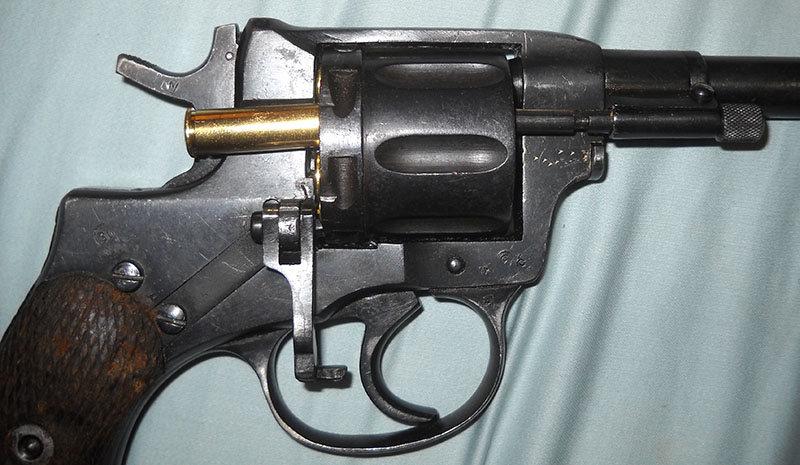
In fairness, and unlike a number of its contemporaries, the Nagant M1895 does have a built-in ejector rod. It's not spring-loaded, so you have to work it back and forth by hand for each round, and it has to be deployed from its centerline storage position and then put away again, but it is at least there, and it's captive to the mechanism so you can't lose it, which is good. Still, taken all together, that leaves you with a sidearm where you have seven shots, and if you need more before the fight is over, um, best of luck. I bought a box of 50 rounds of ammunition for mine not long ago, and I still have 36 of them, because I only had an hour of range time. ;)
On the other hand, that wasn't really seen as much of a drawback at the time. The sidearm was, after all, a secondary or even tertiary weapon, after a soldier's rifle and, arguably, his bayonet. The Nagant was also issued to police agencies, and again, nobody at the time thought a Tsarist police officer was ever going to need to shoot more than seven anarchists at a time. In a really serious gun battle, the expectation was that they wouldn't be alone anyway. The modern "officer must be able to hold out until backup arrives" doctrine did not yet exist. Seven rounds was Good Enough.
It must be said that none of the above prevented the Nagant from having a long and distinguished service career. They were officially adopted in 1895, went into full domestic Russian production in 1898, and, as previously mentioned, the Communists kept making them after they took over the country in 1917. They were officially replaced by the Tokarev TT-33 auto pistol in 1933, but remained in production long after that simply because they were such a proven, reliable, easy-to-produce, easy-to-train-people-on design; the incredibly heavy trigger was even seen as an asset over the Tokarev, since it tended to prevent negligent discharges (a big problem with the Soviet conscript armies of the '30s and '40s).
At any rate, the Tula and Izhevsk Arsenals didn't stop making Nagants until the end of World War II. Even when the Tokarev was itself replaced by the Makarov automatic in the 1950s, the Nagant remained in service with second-line units and police agencies. Russian postal security officers were issued them until - are you ready for this - 2003. In Russian, nagan used to be the word for "revolver", in much the same way that 19th-century Americans called any compact single- or double-shot pistol a "derringer".
The particular one we're looking at here is from quite late in production. Here's a closeup of the arsenal mark on the left side of the frame:
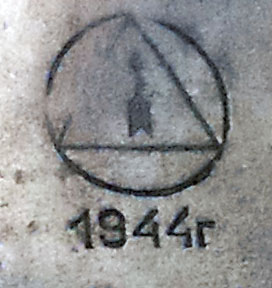
It's partially worn off, but the arrow-in-a-triangle mark is the insignia of the Izhevsk Machine Works (Izhmash), formerly one of the principal Soviet arsenals, and the number in this case means just what it looks like it means. (That thing that looks like a lowercase r is actually г, a lowercase Cyrillic g, short for "год", year.) Not many years after this revolver was made there, Izhmash would become famous or infamous, depending on how you look at it, as the arsenal where the Avtomat Kalashnikova 1947г was developed and initially produced, and where its various descendants are still made. Indeed, today, the plant and neighboring Izhevsk Mechanical Works (Izhmekh) are combined into a single as-private-as-these-things-get-in-Russia industrial group called the Kalashnikov Concern.
I don't know anything else about the specific history of mine, other than that it evidently came into the United States sometime before 1968. I know this because it doesn't have any importer's markings on it, and after 1968 it became a requirement for US importers to defaceadd certain legally required markings to their offerings (you will see this on some of the other items in later Gun of the Week installments). I bought it some years ago from a now-defunct online dealer that mostly traded in Makarovs, but also did a sideline in other Soviet handguns when they could get them.
Until fairly recently, Nagants were dirt cheap on the US market, and even now that you can get ammunition for them again thanks to the nice folks at PRVI Partizan, they're not what you would call a hot-ticket item. They're not likely to be this Christmas's Tickle Me Elmo. :)
Still, I like mine, and though I'm not going to be doing a lot of shooting with it in order to delay the onset of arthritis in my trigger finger, I'm glad I have one. It's a simple, honest, rugged piece of military engineering, well-made despite the fairly desperate conditions under which it must have been manufactured (Izhevsk in 1944 was not a place where a lot of fine finish work got done), and it has connections to a lot of interesting corners of European firearms history thanks to the Liège connection - a connection that we'll come back to later on, when we start getting into the works of John Browning.
--G.
* Even today, there is considerable controversy in some circles as to how much of a contribution Émile Nagant actually made to what is still known in Russia as the Mosin rifle. This could easily be its own Gun of the Week, but basically, Sergei Mosin and Nagant were competitors in the 1891 rifle competition, which Mosin's rifle won, and Nagant later sued the Russian government for infringing on his patent for a design feature which the Russians claimed Nagant swiped from Mosin, who hadn't bothered to patent it, in the first place.
** So effective is the Nagant's gas seal at reducing noise that generations of Russian and Soviet secret police organizations, from the Tsarist Okhrana to the Bolshevik Cheka and its successors, fitted them with suppressors and used them as assassination weapons, a job revolvers are usually terrible at - and a job they were still doing for the Việt Cộng in the 1960s.
-><-
Benjamin D. Hutchins, Co-Founder, Editor-in-Chief, & Forum Mod
Eyrie Productions, Unlimited http://www.eyrie-productions.com/
zgryphon at that email service Google has
Ceterum censeo Carthaginem esse delendam.

 Printer-friendly copy
Printer-friendly copy















